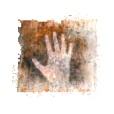Please wait a few moments while we process your request

Robert Cahen
Biography
Robert Cahen’s work with video first developed as the result of his studies of electroacoustic composition with Michel Chion and Pierre Schaeffer at the Conservatoire national supérieur de musique (CNSM) in Paris in the late 1960s and early 1970s. Within this context, Cahen developed a video aesthetic grounded in the principles of time in musical structuring and the ambivalence of the various ‘time zones’ interacting with each other. Interestingly, Cahen unfolds this structure by using narrative components that derive from cinema: in Juste le temps (1983, F), Cahen introduces the narrative motif of a train journey in order to intersect different experiences of time associated with a woman sitting in a train compartment and a man stepping into this compartment. When they watch each other and look out of the window, the image is temporally manipulated through scan processing (which resembles the Rutt/Etra Scan Processor used by the Vasulkas and Gary Hill). The overlapping of these varying views creates an abstract composition, a passage of images (défilement – a term introduced by Thierry Kuntzel), which cannot be attributed to the specific perspective of each individual’s sights. In an interview with Jean-Paul Fargier, Cahen explained that in Juste le temps the perspective was that of the individual seated – the traveller’s impression of what was taking place. Cahen wanted to emphasize that when we look to the distance, we do not see the same things that we see when viewing something close up. (1)
Yvonne Spielmann © 2005 FDL
(1) “Entretien avec Robert Cahen,” Cahiers du Cinéma, Hors Série, “Où va la vidéo?” edited by Jean-Paul Fargier, 1986, p. 40.


